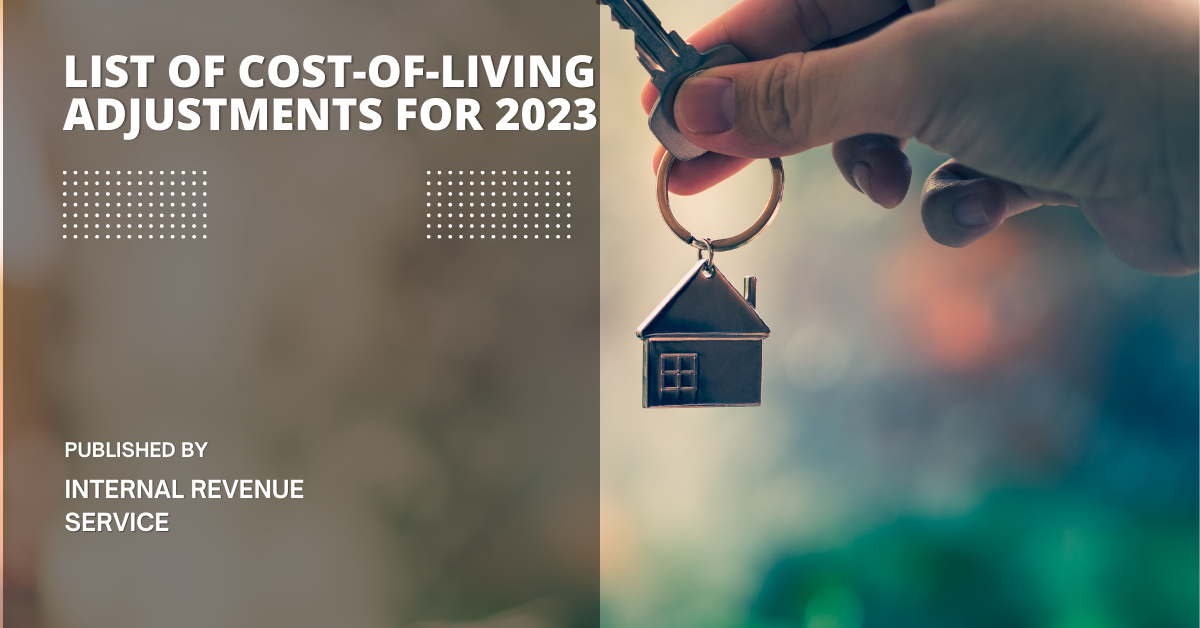List of cost-of-living adjustments published by Internal Revenue Service for 2023: Some of the greatest cost-of-living increases in US history were just issued by the Internal Revenue Service. High inflation rates during much of 2022 resulted in an unprecedented rise in Social Security payouts, the maximum contributions to retirement plans, and other things like gifting and contributions to health savings accounts.
You may need to change how you approach your budget and tax plans, as well as how much you contribute to specific accounts, in light of the considerable changes in these areas. Here are the significant cost-of-living increases starting in 2023 to help with this.
Social Security: The benefits of recipients will increase by 8.7%.
basis for social security. From $147,000 in 2022 to $160,200 in 2023, the maximum amount of earned income for which employees must pay Social Security taxes.
Social Security salary base: From 2022 to 2023, the amount of earned income that can be subject to Social Security taxes was raised from $147,000 to $160,200.
Tax brackets: Although the income brackets were raised, the tax rates remained the same.
Income tiers and capital gains rates: Although the income tier that determines the rate grew, the capital gains rates stayed the same.
Maximum contributions to traditional and Roth individual retirement accounts (IRAs): The maximum amount that can be put into these accounts has gone boosted from $6000 in 2022 to $6500. The maximum contribution for persons over 50 is $7500 because the “catch-up” contribution was left at $1000.
Income thresholds for traditional IRA deductions: For those who participate in employment retirement plans (such as 401[k]), the phaseout range for being eligible to deduct traditional IRA contributions starts at a modified adjusted gross income (MAGI) of $73,000 and stops at $83,000 for single people. The phaseout range rose to between $116,000 and $136,000 for married couples filing jointly. The MAGI phaseout range increases to between $218,000 and $228,000 if an IRA contributor is not protected by an employment retirement plan but their spouse is. The phaseout range stays between $0 and $10,000 for a married person filing a separate return who is protected by an employment retirement plan. Roth IRA MAGI phaseout rose to between $138,000 and $153,000 for taxpayers who file as single or head of household.
Roth IRA contribution income limits: The phaseout range for married couples paying jointly taxes starts at $218,000 and finishes at $228,000. The phaseout range for married couples who file their taxes separately continues to be $0 to $10,000.
Maximum contribution to a Savings Incentive Match Plan for Employees (SIMPLE) IRA: The maximum salary-based contribution an employee may make to a SIMPLE IRA in 2023 is $15,500, up from $14,000 in 2022.
Maximum contribution to a Simplified Employee Pension Plan IRA: With the maximum countable compensation increasing to $330,000, the maximum Simplified Employee Pension Plan IRA contribution amount was raised to $66,000.
Standard deduction: For single taxpayers and married couples filing separately in 2023, the standard deduction rose by $900 to $13,850. For a married couple filing jointly in 2023, the new standard deduction will be $27,700. For 2023, married taxpayers who are 65 years of age or older can increase their standard deduction by $1500. If you’re single or the surviving spouse of a married couple, this rises to $1850.
Alternative Minimum Tax Exemptions and Phaseout Ranges: The exemption amounts for joint filers and single taxpayers, respectively, increased to $126,500 and $81,300, respectively, for 2023. The 2023 inflation-adjusted phaseout ranges for single filers are now $578,150 to $903,350 and married joint filers are $1,156,300 to $1,662,300. The sums for married couples filing separately are twice as much as those for joint filers.
Gift tax exclusion amount: In 2022, the annual exclusion for gifts will be $16,000; in 2023, it will be $17,000.
Basic inheritance exemption from estate taxes: In 2023, the exemption amount will rise from $12,060,000 to $12,920,000.
We strongly advise you to consult with your certified public accountant as you make plans for the 2023 tax year. They might provide extra techniques to reduce your tax impact all year long in addition to conventional tax preparation.
